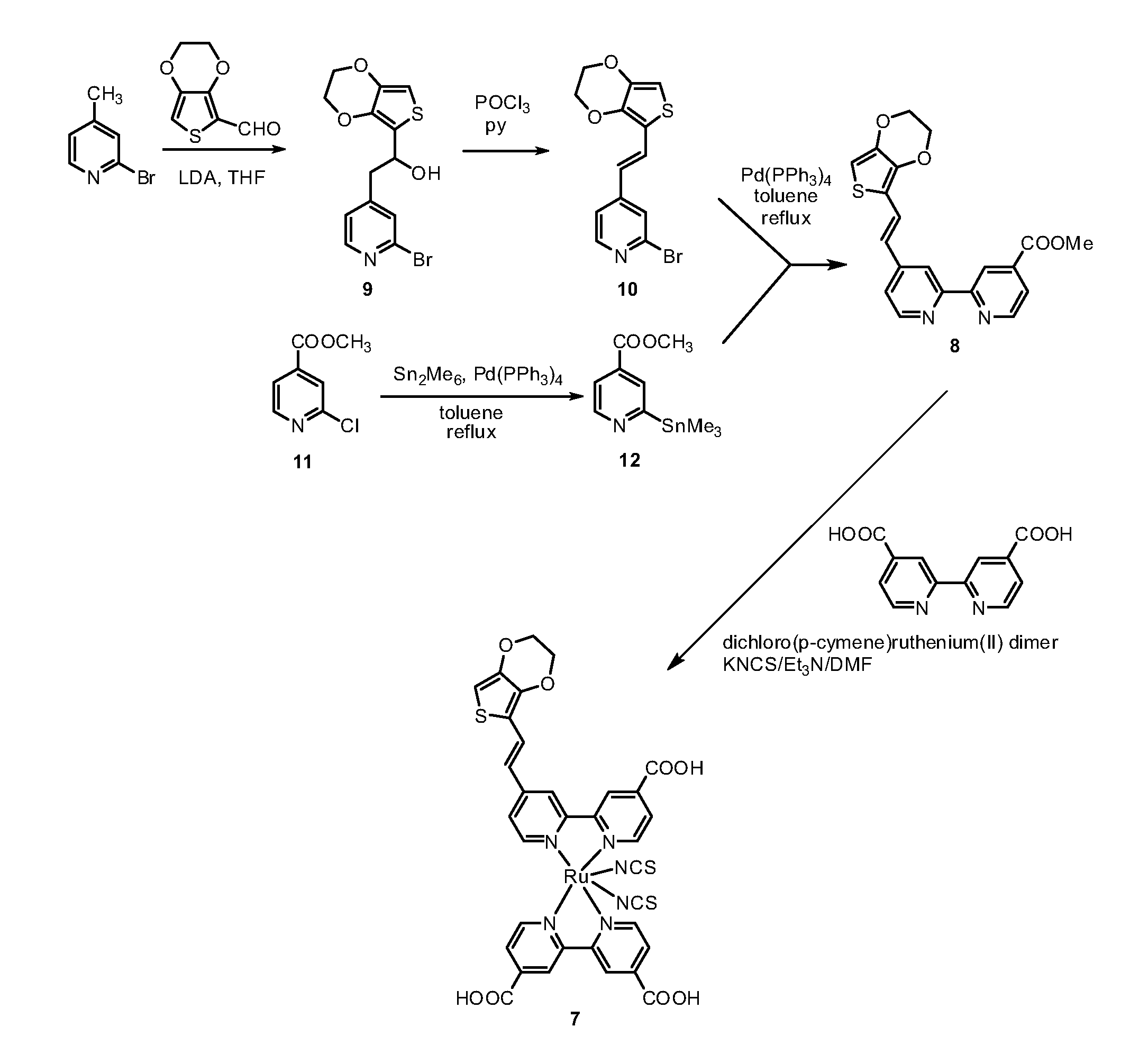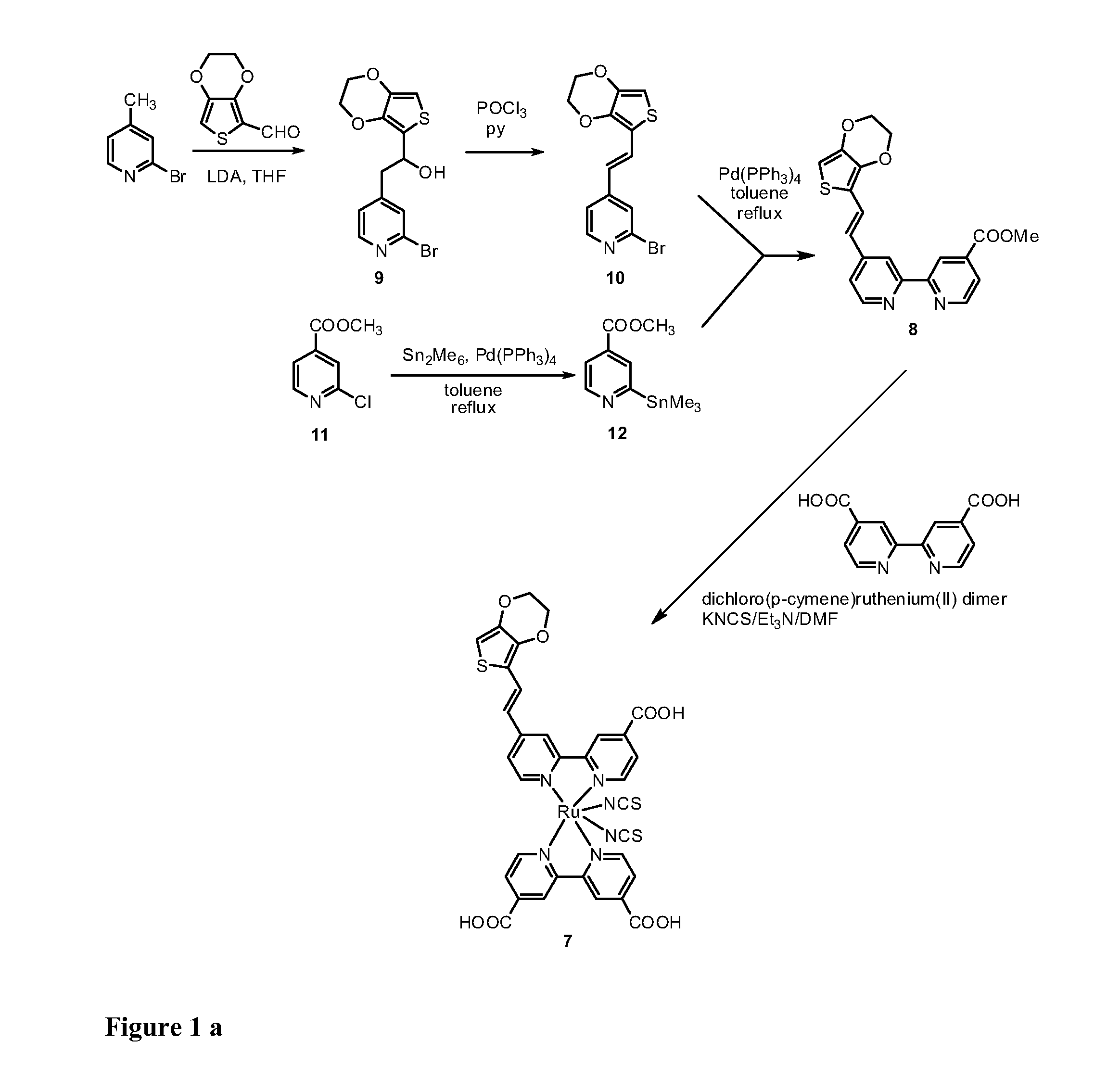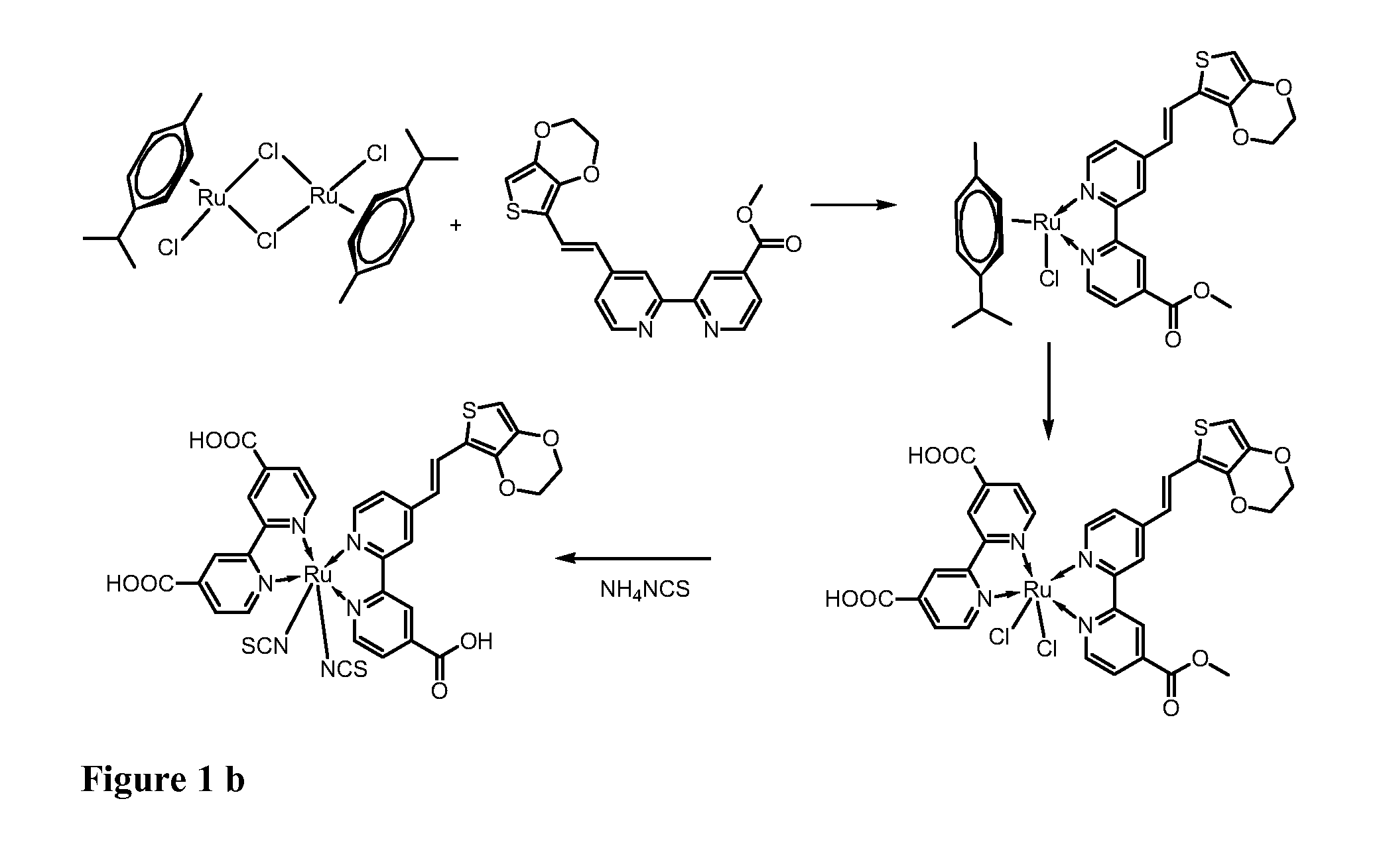Novel ligands for sensitizing dyes of dye-sensitized solar cells
a solar cell and sensitization technology, applied in the field of new biand polypyridine compounds, can solve the problems of heteroleptic ru(ii)-dyes that have not provided increased performance when employed in dscs, and the match between the absorption band of dye, limited to the uv-vis region, and the solar emission, etc., to achieve the effect of increasing the overall power conversion efficiency of dye-sensitized solar cells
- Summary
- Abstract
- Description
- Claims
- Application Information
AI Technical Summary
Benefits of technology
Problems solved by technology
Method used
Image
Examples
example 1
Synthesis of the Ligand 4-[2-(3,4-Ethylenedioxythien-2-yl)vinyl]-4′-methoxycarbonyl-2,2′-bipyridine (8) (Hydrolized Product of Precursor 8 Shown in FIG. 1a)
[0120]The synthesis of the bi-pyridine compound (8) and of the dye (7) are schematically illustrated in the scheme of FIGs. 1a and 1b.
a) 2-(2-Bromopyrid-4-yl)-1-(3,4-ethylenedioxythien-2-yl)ethanol (9).
[0121]4-Methyl-2-bromopyridine (450 mg, 2.62 mmol) was dissolved in anhyd THF (10 mL) and the resulting mixture was cooled to −78° C. LDA (1.76 mL, 1.8 M solution in THF, 3.17 mmol) was added dropwise and the resulting mixture was stirred for 1 h at the same temperature. A solution of 3,4-ethylenedioxythiophene-2-carboxaldehyde (500 mg, 2.94 mmol) in THF (20 mL) was added and the resulting mixture was stirred for 30 min at room temperature. AcOEt (120 mL) and water (120 mL) were added and the layers were separated. The organic layer was washed with water (2×150 mL), dried (Na2SO4) and the solvent was removed by rotary evaporation....
example 2
Synthesis of the dye [Cis-(dithiocyanato)-Ru-(4,4′-dicarboxylate-2,2′-bpy)-[4-carboxylate-4′-[(E)-2-EDOTvinyl]-2,2′-bpy] (7)
[0125]A mixture of [{RuCl2(p-cymene)}2] (64 mg, 0.11 mmol) and Ligand (80 mg, 0.21 mmol) was vacuum-dried and added DMF (30 ml) and the reaction mixture was heated at 80° C. under nitrogen for 4 h. Then, bipyridyl(carboxylic acid) (51 mg, 0.21 mmol) was added to the solution and refluxed at 160° C. for another 4 h under dark condition. Excess of NH4NCS 30H2O (96 mg, 1.26 mmol) was added to the reaction mixture and heated at 130° C. for further overnight (8 h). Thereafter, the solvent was removed using a vacuum distillation. Water was added to the resulting semisolid to remove excess NH4NCS. The water-insoluble product was collected on a sintered glass crucible by suction filtration and washed with distilled water. Then, the crude complex was dissolved in a solution of tetrabutyl ammonium hydroxide in methanol, loaded on a Sephadex LH-20 (2×30 cm) column and elu...
example 3
Synthesis of the tetrapyridine ligand trans-dithiocynato [Ru(4,4′″-bis[(E)-2-(3,4-ethylenedioxythien-2-yl)vinyl]-4′,4″-bis(methoxycarbonyl)-2,2′:6′,2″:6″,2′″-quaterpyridine)] (13)
[0126]The synthesis of the quaterpyridine precursor compound (14) and of the dye (13) are schematically illustrated in the scheme of FIG. 2.
a) 4-[2-(3,4-Ethylenedioxythien-2-yl)vinyl]-2-(trimethylstannyl)pyridine (15).
[0127]Hexamethyldistannane (230 μl, 365 mg, 1.11 mmol) and tetrakis(triphenylphosphine)palladium(0) (20 mg, 0.017 mmol) was added to a solution of (10) (325 mg, 1.00 mmol) in anhyd toluene (20 mL) and the resulting mixture was refluxed for 12 h. Water (100 mL) and AcOEt (100 mL) were added and the layers were separated. The organic layer was washed with water (5×100 mL), dried (Na2SO4), and the solvent removed under reduced pressure to afford (15) as a colourless oil (355 mg, 0.87 mmol, 87%) which was used without further purification in the next step.
b) 4,4″′-Bis[2-(3,4-ethylenedioxythien-2-y...
PUM
| Property | Measurement | Unit |
|---|---|---|
| structure | aaaaa | aaaaa |
| Π-conducting character | aaaaa | aaaaa |
| aromatic properties | aaaaa | aaaaa |
Abstract
Description
Claims
Application Information
 Login to View More
Login to View More - R&D
- Intellectual Property
- Life Sciences
- Materials
- Tech Scout
- Unparalleled Data Quality
- Higher Quality Content
- 60% Fewer Hallucinations
Browse by: Latest US Patents, China's latest patents, Technical Efficacy Thesaurus, Application Domain, Technology Topic, Popular Technical Reports.
© 2025 PatSnap. All rights reserved.Legal|Privacy policy|Modern Slavery Act Transparency Statement|Sitemap|About US| Contact US: help@patsnap.com



